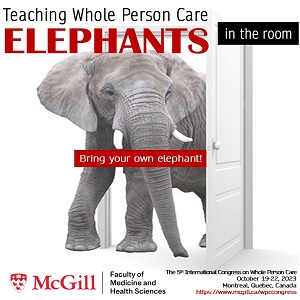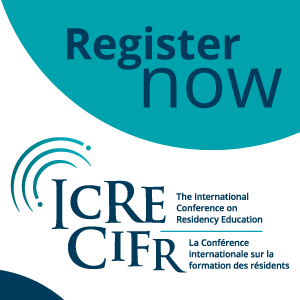Cinq stratégies pour mieux structurer les stages cliniques pendant une pandémie
DOI :
https://doi.org/10.36834/cmej.74000Résumé
Pendant la pandémie de la COVID-19, la tâche de préparer les étudiants aux stages d'externat et de soutenir la construction de leur identité professionnelle est devenue plus difficile. La structure traditionnelle de l’externat a été remise en question et révolutionnée, car la COVID-19 a accéléré le développement et la mise en œuvre de la technologie des soins en santé et de l’apprentissage assisté par la technologie. Cependant, l’intégration des activités d’apprentissage et d’enseignement, et l’application de principes pédagogiques éprouvés dans l’enseignement supérieur restent difficiles à mettre en pratique dans le contexte actuel de pandémie. Dans cet article, prenant le cours de transition vers l’externat comme exemple, nous décrivons les étapes que nous avons suivies pour organiser notre stage d’externat et les défis rencontrés sur le plan du cursus par les diverses parties prenantes, et nous présentons les leçons pratiques que nous en avons tirées.
Statistiques
Références
Candy PC. Self-direction in lifelong learning. San Francisco: Jossey-Bass; 1991.
Knowles MS. The modern practice of adult education: from pedagogy to andragogy. 2nd ed. New York: Cambridge Books; 1980.
Merriam SB, Caffarella RS, Baumgartner LM. Learning in adulthood: a comprehensive guide. 3rd ed. San Francisco: Jossey-Bass; 2007.
Ryan RM, Deci EL. Self-determination theory and the facilitation of intrinsic motivation, social development, and well-being. Am Psychol. 2000;55(1):68-78. http://doi.org/10.1037/0003-066X.55.1.68
Thomas PA, Kern DE, Hughes MT, Chen BY. Curriculum development for medical education: a six-step approach. Baltimore: Johns Hopkins University Press; 2016.
Centers for Disease Control. Introduction to program evaluation for public health programs [homepage on the Internet]. 2012. Available from https://www.cdc.gov/eval/guide/step1/index.htm [Accessed Feb 26, 2021].
Schmeer K. Stakeholder analysis guidelines. In Policy Toolkit for Strengthening Health Sector Reform [Internet]. Washington. Regional Office of the World Health Organization; 2010 Available from: https://www.paho.org/hq/dmdocuments/2010/47-Policy_Toolkit_Strengthening_HSR.pdf [Accessed Oct 15, 2021].
Kirkpatrick JD. Evaluation of training. In: Craig R, Mittel I, editors. Training and development handbook 87-112. New York: McGraw Hill; 1967.
Hattie J, Timperley H. The power of feedback. Rev. Educ. Res. 2007;77(1):81-112. http://doi.org/10.3102/003465430298487
Centre for Medical Education. Curriculum Theories [homepage on the Internet]. 2021. Available from https://pgmed.dundee.ac.uk/mod/book/view.php?id=34188 [Accessed on Oct 15, 2021].
Frank JR, Snell LS, Cate OT, et al. Competency-based medical education: theory to practice. Med Teach. 2010;32(8):638-645. http://doi.org/10.3109/0142159X.2010.501190
Harden RM, Crosby JR, Davis MH, Friedman M. AMEE Guide No. 14: Outcome-based education: Part 5-From competency to meta-competency: a model for the specification of learning outcomes. Med Teach. 1999;21(6):546-552. http://doi.org/10.1080/01421599978951
Irby D, Cooke M, O‘Brien B. Calls for reform of medical education by the Carnegie Foundation for the Advancement of Teaching: 1910 and 2010. Acad Med. 2010;85(2):220-7. http://doi.org/10.1097/ACM.0b013e3181c88449
Royal College of Physicians and Surgeons of Canada. Competency by Design: Canada’s model for competency-based medical education. 2021. Available from https://www.royalcollege.ca/rcsite/cbd/competence-by-design-cbd-e [Accessed on Feb 27, 2021]
North W. Curriculum-product or process. 2007. Available from https://www.asccc.org/content/curriculum-product-or-process [Accessed Mar 2, 2021].
Kelly AV. The curriculum: theory and practice. 6th ed. London: Sage; 2009.
Talbot M. Monkey see, monkey do: a critique of the competency model in graduate medical education. Med Educ. 2004;38(6):587-592. http://doi.org/10.1046/j.1365-2923.2004.01794.x
Smith MK. Curriculum theory and practice: the encyclopedia of pedagogy and informal education. 2000. Available from www.infed.org/biblio/b-curric.htm [Accessed Mar 3, 2021].
Bandura A. Self-efficacy: toward a unifying theory of behavioral change. Psychol Rev. 1977;84(2):191-215. https://doi.org/10.1037/0033-295X.84.2.191
Knobloch AC, Ledford CJW, Wilkes S, Saperstein AK. The impact of near-peer teaching on medical students' transition to clerkships. Fam Med. 2018;50(1):58-62. http://doi.org/10.22454/FamMed.2018.745428
O'Brien BC, Poncelet AN. Transition to clerkship courses: preparing students to enter the workplace. Acad Med. 2010;85(12):1862-1869. http://doi.org/10.1097/ACM.0b013e3181fa2353
Teo T. Factors influencing teachers' intention to use technology: model development and test. Comput Educ. 2011;57:2432–2440. https://doi.org/10.1016/j.compedu.2011.06.008
Turner SR, White J, Poth C, Rogers WT. Preparing students for clerkship: a resident shadowing program. Acad Med. 2012;87(9):1288-1291. http://doi.org/10.1097/ACM.0b013e3182623143
Lave J, Wenger E. Situated learning: legitimate peripheral participation. New York: Cambridge University Press; 1991. https://doi.org/10.1017/CBO9780511815355
Merrill MD. First principles of instruction. Educ Tech Res. 2002;50(3):43-49. http://doi.org/10.1007/BF02505024
Vygotsky LS. Mind in society: the development of higher psychological process. Cambridge: Harvard University Press; 1978.
Kolb DA. Experiential learning: experience as the source of learning and development. Englewood Cliffs: Prentice Hall; 1984.
Mezirow J. Understanding transformation theory. Adult Educ Q. 1994;44(4):222-244. https://doi.org/10.1177/074171369404400403
Mookerji N, El-Haddad J, Vo TX, Grose E, Seabrook C, Lam BK, Feibel R, Bennett S. Evaluating the efficacy of self-study videos for the surgery clerkship rotation: an innovative project in undergraduate surgical education. Can J Surg. 2021 Jul 29;64(4):E428-E434. https://doi.org/10.1503/cjs.019019
Emergency Medicine Cases. What is FOAMed? Available from https://emergencymedicinecases.com/about/foamed/ [Accessed Oct 15, 2021].
Welsh L, Parekh K, Brumfield E. FOAM in the EM clerkship: clerkship director attitudes and practices using FOAM in emergency medicine clerkships. (2018). West J Emerg Med. 2018;19(4.1)
Glatthorn AA, Boschee BF, Whitehead BM. Curriculum leadership: strategies for development and implementation. 3rd ed. London: Sage; 2012.
Ende J, Davidoff F. What is a curriculum? Ann Intern Med. 1992;116(12 Pt 2):1055-1057. http://doi.org/10.7326/0003-4819-116-12-1055
Reis S. Curriculum reform: Why? What? How? and how will we know it works? Isr J Health Policy Res. 2018;7(1):30. https://doi.org/10.1186/s13584-018-0221-4
Schön DA. The reflective practitioner: how professionals think in action. New York: Harper; 1983.
Ng SL, Wright SR, Kuper A. The divergence and convergence of critical reflection and critical reflexivity: implications for health professions education. Acad Med. 2019;94(8):1122-1128. http://doi.org/10.1097/ACM.0000000000002724
Salas E, Klein C, King H, et al. Debriefing medical teams: 12 evidence-based best practices and tips. Jt Comm J Qual Patient Saf. 2008;34(9):518-527. http://doi.org/10.1016/s1553-7250(08)34066-5
Téléchargements
Publié-e
Comment citer
Numéro
Rubrique
Licence
(c) Tous droits réservés K Jean Chen, Samuel Wilson, Warren Cheung 2019

Cette œuvre est sous licence Creative Commons Attribution - Pas d'Utilisation Commerciale - Pas de Modification 4.0 International.
La soumission d’un manuscrit original à la revue constitue une indication qu’il s’agit d’un travail original, qu’il n’a jamais été publié et qu’il n’est pas envisagé pour publication dans une autre revue. S’il est accepté, il sera publié en ligne et ne pourra l’être ailleurs sous la même forme, à des fins commerciales, dans quelque langue que ce soit, sans l’accord de l’éditeur.
La publication d’une recherche scientifique a pour but la diffusion de connaissances et, sous un régime sans but lucratif, ne profite financièrement ni à l’éditeur ni à l’auteur.
Les auteurs qui publient dans la Revue canadienne d’éducation médicale acceptent de publier leurs articles sous la licence Creative Commons Paternité - Pas d’utilisation commerciale, Pas de modification 4.0 Canada. Cette licence permet à quiconque de télécharger et de partager l’article à des fins non commerciales, à condition d’en attribuer le crédit aux auteurs. Pour plus de détails sur les droits que les auteurs accordent aux utilisateurs de leur travail, veuillez consulter le résumé de la licence et la licence complète.












